
By Elissa Goldstein

In 2012, a calamity struck kosher-baking enthusiasts in the United States when the supermarket chain Trader Joe’s changed the certification on its semisweet chocolate chips from pareve to dairy. After the news broke, consumers rushed into stores to stockpile the remaining pareve packets, bemoaning the dearth of good-quality, kosher-certified, affordable bittersweet chocolate. Of course, there are other pareve chocolate chips on the market, but the urgency highlighted how important dark chocolate is to Jewish cooking.
If you follow Jewish dietary laws, you can serve a chocolate dessert after a meat main only if it’s dairy-free. And no one wants to endure a three-day yontef without chocolate. Imagine Passover without a flourless chocolate torte or matzo buttercrunch or chocolate mousse. (It’s very upsetting, right?) There are many substitutes for butter and milk, but when a recipe calls for chocolate, you need . . . chocolate.
Jews played an important role in the European cacao trade in the seventeenth century, and they weren’t trading milk chocolate, which was invented only in 1875. The truth is, bittersweet chocolate is the best kind there is. (Fight me. I dare you.) Dark chocolate is complex, not cloying, and pairs well with other ingredients. It can be serious or playful. It’s even good for you! Is it a stretch to say that the higher the percentage of cacao, the Jewier the chocolate? I don’t think so. In life, as in dessert, Jews know from bittersweet.
Flourless Chocolate Cake
Adapted from a recipe by Alison Cayne
Makes one 9-inch (23-centimeter) cake or eight 6-ounce (175-milliliter) ramekins
¾ cup (1¾ sticks/192 grams) margarine, such as Earth Balance, or unsalted butter, plus more for greasing
8 ounces (227 grams) bittersweet chocolate (70% cacao or more), chopped
5 large eggs
¾ cup (150 grams) sugar
Fine sea salt
¼ cup (35 grams) almond meal (optional)
Preheat the oven to 375ºF (190ºC). Grease the sides of a 9-inch (23-centimeter) round cake pan and line the bottom with a round of parchment paper cut to fit. (Alternatively, grease eight 6-ounce/175-milliliter ramekins to make individual cakes.)
Melt the margarine in a small pot over medium heat, stirring occasionally. Remove from the heat and add the chocolate. Stir continuously until the chocolate has melted and the mixture is well combined. Set aside to cool.
In the bowl of a stand mixer fitted with the whisk attachment or in a large bowl using a handheld mixer, beat the eggs, sugar, and a pinch of salt on medium-high speed until pale yellow and doubled in volume, about 3 minutes.
Using a silicone spatula, fold the melted chocolate mixture into the whipped eggs in three additions so the chocolate doesn’t sink to the bottom and the batter remains nicely aerated.
Fold in the almond meal (if using), then pour the batter into the prepared pan or divide it evenly among the prepared ramekins. If using a cake pan, set it on an even surface and give it a quick spin, which will cause the batter to climb up the sides of the pan and bake more evenly.
Bake until the top is set and dry to the touch, 20 to 25 minutes for a 9-inch (23-centimeter) cake or 10 to 15 minutes for ramekins.
Let cool in the pan (or ramekins) on a wire rack for at least 30 minutes before serving.

By Roya Hakakian
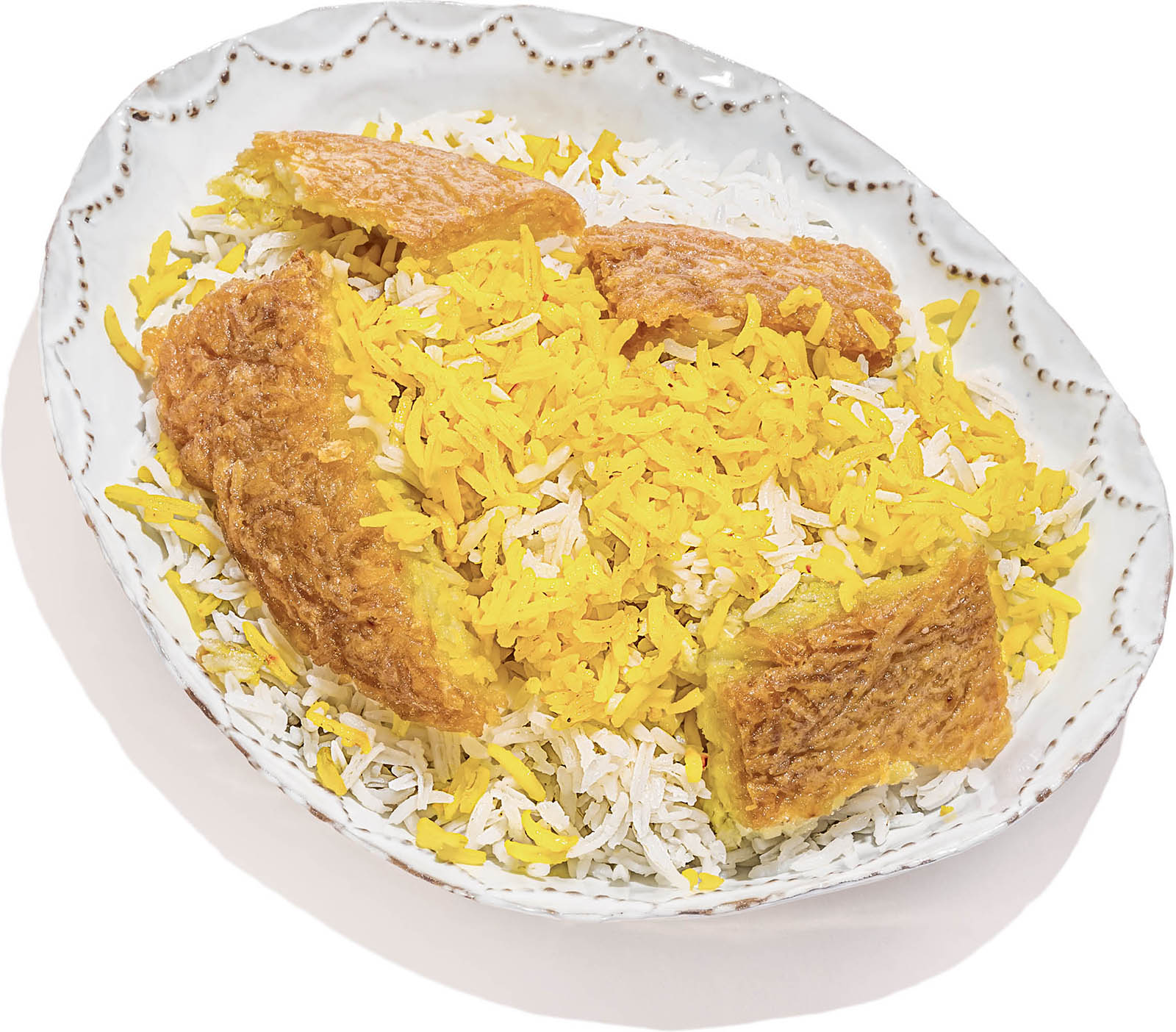
For all the love lavished upon lumpy Ashkenazi darlings such as the bagel, kugel, and matzo ball, it is indeed Persian rice that, if it came down to it, could serve as the Jewish people’s most fitting alimentary metaphor. Lean, distinct grains, negligible on their own, become gastronomically substantial when together on a spoon or in a mound on the tray. Come what may, be it herb (dill, leek, parsley) or spice (cumin, cinnamon, cardamom) or bean (fava, green, or black-eyed pea) or fruit (raisin, barberry, cranberry), Persian rice blends them all into a sumptuous sum far greater than its separate parts.
While the palatable repast might lead the epicure to believe mere lightness accounts for the taste, the crusty, bottom-of-the-pot concoction offers a tough rebuttal, leaving room for many interpretations, for instance, this: Only with so hardened a bottom does such lightness on top become possible. And can one make this dish from a mere recipe? Queen Esther would advise against it, if she could. It takes serious dedication to learning by the side of a culinary chacham to create the crusty-fluffy paradox without involving the local fire chief, not so metaphorically speaking!
Persian Rice
Serves 8 to 10
2 ½ cups (500 grams) white basmati rice, such as Lal Qilla
½ cup plus 1 tablespoon (69 grams) kosher salt
½ teaspoon saffron, crushed
1 large egg, lightly beaten
4 tablespoons plus 1 ½ teaspoons (67 milliliters) vegetable oil, such as canola or sunflower, plus more for drizzling
Place the rice in a large bowl and rinse with cold water four to five times, until the water runs clear. Drain the rice and transfer to a large bowl. Add 8 cups (2 liters) warm water and 6 tablespoons (46 grams) of the salt. Soak for at least 3 hours, or up to overnight. Drain the rice.
To cook the rice, use a three-to-one ratio of water to soaked rice. For 5 cups of soaked rice, bring 15 cups (3 liters plus 750 milliliters) water to a boil in a large pot. Add the remaining 3 tablespoons salt (23 grams), 1½ teaspoons (7 milliliters) oil, and the soaked rice. Return to a boil, then reduce the heat to medium-high, so the water is still boiling vigorously. Cook for 7 to 9 minutes, checking the rice after 5 minutes—when it’s ready, it will be softened but still have some bite. Immediately drain the rice in a large colander and rinse with cold water.
Place the saffron in a bowl and steep in 1 tablespoon (15 milliliters) hot water. Add 1 cup of the drained rice, the egg, and ½ teaspoon of the oil. Stir to combine.
To get the crispy tahdig layer, in a tall, heavy-bottomed pot with a 9-inch base, add the remaining 3 tablespoons (45 milliliters) oil and heat over high heat until shimmering, about 2 minutes. Add the saffron mixture and spread evenly over the bottom of the pot. Lower the heat to medium-low and let the mixture crisp up, about 10 minutes.
Place the remaining rice over the tahdig in a mound, and drizzle some oil on top. Cook, uncovered, until steam is rising from the rice, 15 to 20 minutes, making sure that the tahdig does not burn. If you do not see steam rising from the rice, add a few tablespoons of hot water, and watch for the steam to develop.
Reduce the heat to the lowest setting, cover the top of the pot with a paper towel or clean kitchen towel, and close the lid for a tight seal. Cook until the rice is soft and fluffy, about 1 hour.
To serve, scoop all of the rice onto a platter. When you get to the golden layer, lift it from the bottom of the pot, break it up into pieces, and place on top of the rice.
By Gail Simmons
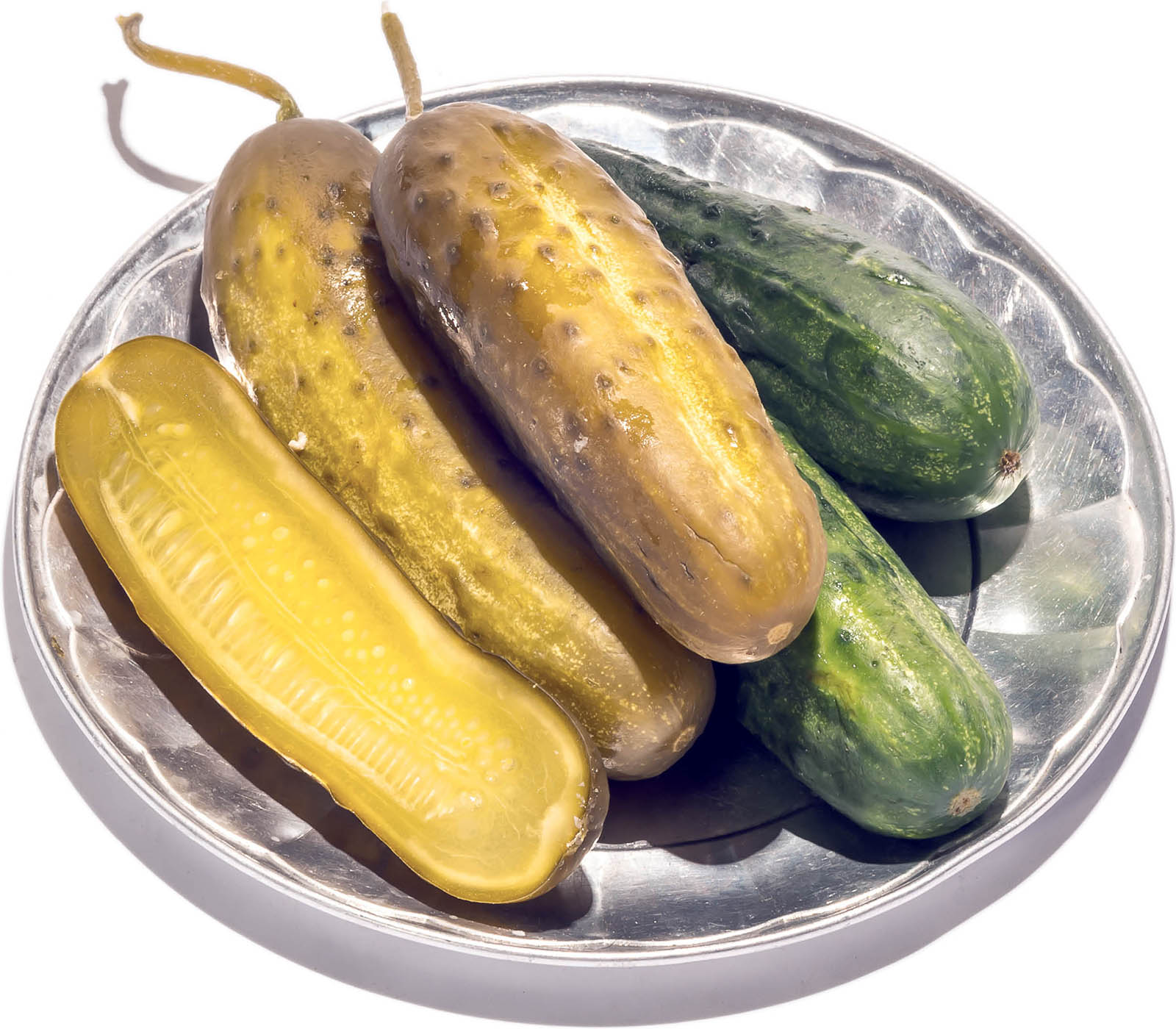
As far back as I can remember, full-sour dill pickles have been the single most important food in my life. There’s no other flavor as satisfying, or that defines my family and my Jewish heritage as perfectly, as a pickle. Allow me to explain: My mother was a fabulous cook. Growing up in Toronto, I was spoiled by the freshly made meals she prepared each day. My father, on the other hand, could barely boil water. But somehow he managed to become our family pickle maker. Each year in late summer, when Kirby cucumbers came into season, my father would drag home a giant bushel from the market, and for two days my mother’s kitchen would become his pickling lab. I cannot imagine our fridge or cellar without a jar or twelve of his full-sour, dill-weed-infused, lip-smacking, face-puckering pickles. We ate them all year round, after school or as midnight snacks, with burgers or roast turkey, piled onto platters and served every Friday night for Shabbat, but also on Rosh Hashanah, Passover, and Hanukkah. No holiday table was complete without them.
In my early twenties, I moved to New York for culinary school. One afternoon, tired and homesick, I went to the Lower East Side looking for a pickle to curb my craving. After tasting a few from the area’s last remaining pickle sellers, I landed on one that did the trick. It wasn’t quite as sour as my father’s; its crunchy exterior didn’t give way to a softer, intensely fermented center exactly as I had hoped, but it came close. And so for the next ten years, I loyally schlepped jars home to my Chelsea apartment whenever time allowed. When I got married in 2008 (to a fellow pickle enthusiast), it seemed only fitting that my father make a hundred jars of pickles to give to our guests as a memento, but the logistics of importing so many pickles across the border in their precious liquid proved insurmountable. So I pleaded with my pickle dealer to sell me jars of his pickles to custom-label for the occasion. He reluctantly agreed, and the wedding went off without a hitch.
A few years later, my husband and I had a daughter. As I watched my friends struggle with picky eaters and infinite demands for candy and sweets, a slow and steady fear took hold. What if my child didn’t like pickles? Thankfully, my husband’s and my predisposed taste buds were passed down to yet another generation, and at five years old, my daughter counts pickles among her favorite foods. We eat them together when I get home from work, on every Jewish holiday, and whenever we see them on restaurant menus. She demands them in her lunch and once in a while for breakfast, too. I couldn’t be more proud. She equates them with her grandfather, and I hope that in time, she will come to think of them as I do: as a vital link to our past and to the generations of Jewish pickle eaters who came before us.
Half-Sour Pickles
Makes about 8 pickles
8 Kirby cucumbers (1 pound/455 grams), thoroughly rinsed
2 tablespoons plus 1 teaspoon (35 grams) kosher salt
1 quart (1 liter) filtered water
5 garlic cloves
3 or 4 sprigs dill
¼ teaspoon dill seed
¼ teaspoon celery seed
¼ teaspoon mustard seed
¼ teaspoon fennel seed
Soak the cucumbers in cold water for 30 minutes and make sure they are free of any grime or dirt. If you like, cut off the non-stem ends, as they often contain a chemical that can make the pickles mushy.
Make a brine by combining the salt and the filtered water in a large bowl. Stir until completely dissolved.
Pack the cucumbers and garlic into a clean 3-quart (3-liter) jar and pour the brine over, making sure the brine covers the cucumbers completely. Make extra brine and add to cover if there isn’t enough. Add the dill sprigs, followed by the dill seed, celery seed, mustard seed, and fennel seed. Cover and refrigerate for 10 days before eating.
The pickles will keep in the refrigerator for up to 1 month.

Full-Sour Pickles
Makes about 8 pickles
8 Kirby cucumbers (1 pound/455 grams), thoroughly rinsed
¼ cup (60 grams) kosher salt
1 quart (1 liter) filtered water
2 garlic cloves, smashed
4 sprigs dill
½ teaspoon dill seed (optional)
¼ teaspoon coriander seed (optional)
Soak the cucumbers in cold water for 30 minutes and make sure they are free of any grime or dirt. If you like, cut off the non-stem ends, as they often contain a chemical that can make the pickles mushy.
Make a brine by combining the salt and the filtered water in a large bowl. Stir until completely dissolved.
Pack the cucumbers and garlic into a clean 3-quart (3-liter) jar and pour the brine over, making sure the brine covers the cucumbers completely. Make extra brine and add to cover if there isn’t enough. Add the dill sprigs and the dill and coriander seeds (if using) and, using a clean wooden spoon, swoosh them around to distribute.
Loosely cover the jar with a lid. Place a plate under the jar to catch any spillover and let the pickles stand at room temperature for 4 days. Every day, loosen the lid to “burp” the jar, then replace the lid to continue the fermentation. After 4 days, scoop out a pickle with a clean utensil, not with your fingers, and cut a piece to taste if it’s sour enough for you—if it is, refrigerate immediately. If not, let the jar stand for up to 3 days more, tasting the pickles each day to see what tastes best to you. You should see the brine becoming cloudy and a few “lazy” bubbles forming here and there—this means you’re on the right track. When the pickles are sour to your liking, seal the jar and store in the refrigerator. The pickles will keep in the fridge for up to 2 months.
By Liel Leibovitz

Think of pkaila as the hipster Jewish dream food: It’s the greatest authentic dish you’ve never heard of. Enjoyed by Tunisian Jews—their Muslim neighbors still know nothing of the dish and its pleasures—it involves gargantuan amounts of spinach fried diligently until nearly charred and then stewed slowly with forgiving cuts of beef or lamb and a small white mountain of beans. Add a forest of cilantro and mint shortly before serving, and you have an aromatic mixture that is the perfect topping for a mound of couscous.
With so much of our contemporary culinary scene dedicated to the breaking down of cultural boundaries and the creation of new food fusions, it’s delightful to see an unreconstructed dish, still unknown and untouched, belonging only to those who took the time and toiled to cook it on Rosh Hashanah and the occasional Shabbat. It’s the opposite of that famous Levy’s rye bread ad—you do have to be Jewish to love pkaila.
Pkaila
Serves 4 to 6
¼ cup (60 milliliters) olive oil
1 medium yellow onion, chopped
1 pound (455 grams) spinach, coarsely chopped
1½ teaspoons salt
2 teaspoons coarsely chopped fresh thyme
½ cup (15 grams) coarsely chopped fresh mint
1½ cups (75 grams) coarsely chopped fresh cilantro
¼ teaspoon ground cinnamon
1 tablespoon (2 grams) ground cumin
1 tablespoon (2 grams) ground coriander
2 garlic cloves, chopped
1 small red chile, such as Fresno, serrano, or similar, cut lengthwise
1 cup (262 grams) dried white beans, such as navy, cannellini, or similar, soaked overnight
6 to 7 cups (1.4 to 1.7 liters) chicken stock or water
2 pounds (900 grams) lamb shoulder or lamb stew, cut into 2-inch (5-centimeter) pieces
4 medium Yukon Gold potatoes (740 grams), peeled and halved
Preheat the oven to 300ºF (148ºC).
Heat the oil over medium high heat in a large heavy pot with a lid. Add the onion to the pot and cook until the onions are soft and fragrant but not changing color, about 5 minutes. Add the spinach, season with ½ teaspoon of the salt, and cook, stirring frequently, until wilted, about 3 minutes.
Add the thyme, mint, cilantro, cinnamon, cumin, coriander, garlic, chile, and white beans. Add the stock or water and the remaining 1 teaspoon salt and stir to combine. Add the meat and bring to a simmer.
Cover and move the pot to the oven. Cook covered for 30 minutes.
Add the potatoes to the pot, cover, and return to the oven for another hour. When the meat is fork tender and the beans and potatoes are cooked through, the dish is ready. Taste and adjust seasoning if needed and serve.
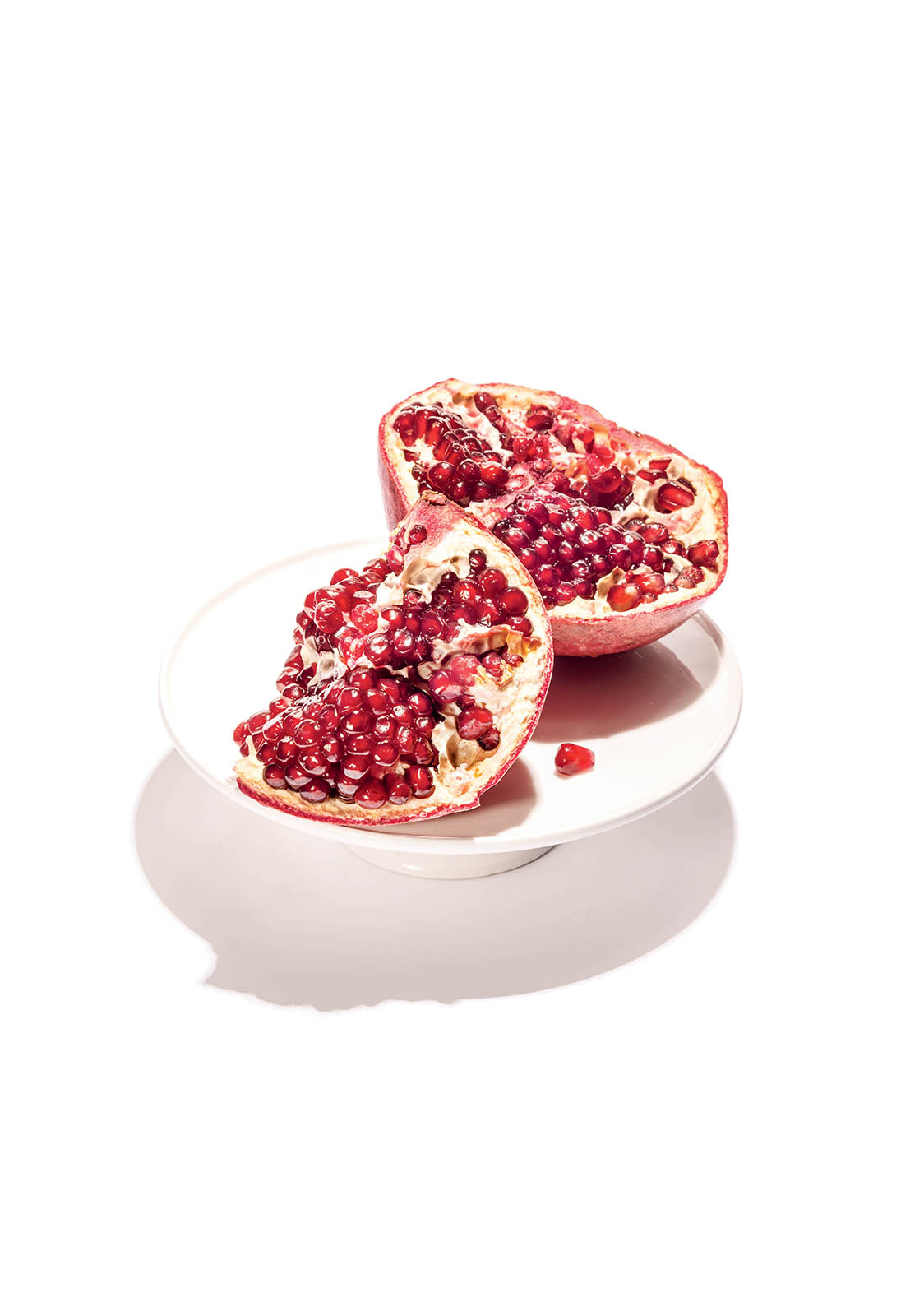
By Dr. Ruth Westheimer
Pomegranate is one of the foods that are actually mentioned in the Bible. It has to do with pru urvu: the commandment to be fruitful and multiply. And it is a very sexy food—it’s sweet and has little seeds in it, and it looks round, so I can understand why they thought it was a nice food for talking about multiplying. It also has 613 seeds, the number of bones in the human body. Some people also say pomegranates are good for fertility. I don’t know if that’s true or not. I do know that pomegranates are great, but it takes effort to eat one. That’s definitely like good sex: It takes work for both to be good lovers.
A Schmutz-Free Method for Seeding Pomegranates
Freeing the seeds from a pomegranate doesn’t have to be a messy affair. It can actually be easy. Start by choosing a nice piece of fruit, one that’s heavy for its size and has a deep-red hue. Place the pomegranate frilly-side up on a cutting board and, using a sharp knife, score the skin around the equator, taking care not to cut into the juicy seeds. Now pull the two halves apart with your hands. They should come apart without spilling any juice. Hold one pomegranate half, cut-side down, over a large bowl, and start tapping on the skin using the back of a metal or wooden spoon. The seeds will start dropping into the bowl. Tap all over until all the seeds are out, and repeat with the second half.
By Gabriella Gershenson

Poppy seeds are hard-to-explain delicious—floral but gritty, welcome and yet peskily ever-present (especially between your teeth). Their taste is earthy, elemental. Sweet filling made from poppy seeds looks like potting soil; indeed, the actual seeds enter this world in the bellies of flowers. The crunchy, nutty specks are as much a source of texture and color as they are of flavor and, even more so, of identity.
Poppy seeds are a motif in the great foods of the Jewish canon, in hamantaschen, flódni, and yeast-dough strudels, on challah, bialys, and bagels; and are eaten in places where Jews once thrived, from Alsace, France, to deep Russia. Though these communities are diminished or gone, that sprinkling of black seeds on your lap, in the bag your everything bagel came in, in the trendy halvah you smuggled home from Israel, are lingering reminders of who we are, a trail of where we came from.
Mohn Kichlach (Poppy Seed Cookies)
by Stacey Harwood-Lehman
Makes thirty-six 1½-inch or forty-eight 1-inch cookies
2 large eggs, at room temperature
½ cup (100 grams) sugar
⅓ cup (80 milliliters) vegetable oil
2½ cups (315 grams) unbleached all-purpose flour, plus more for rolling
¼ cup (40 grams) poppy seeds
¾ teaspoon baking powder
Pinch of kosher salt
1 large egg yolk
1 tablespoon (30 milliliters) water
In the bowl of a stand mixer fitted with the whisk attachment, beat the eggs and sugar on medium speed for about 3 minutes, until pale yellow. Continue beating while adding the oil in a thin, steady stream, beating until the oil is incorporated.
Combine the flour, poppy seeds, baking powder, and salt in a medium bowl, and using a whisk, mix until the ingredients are evenly distributed throughout.
Stop the mixer, then add the dry ingredients to the egg mixture. Turn the mixer speed to low and mix until the dough just comes together. The dough should have the consistency of rich tart dough—pliable and moist, not dry or sticky.
Turn the dough out onto a piece of plastic wrap, shape it into a ball, flatten it slightly to get a thick disk, and refrigerate for 1 hour or up to 24 hours.
When ready to bake, position a rack in the center of the oven and preheat the oven to 350ºF (177ºC). Line a cookie sheet with parchment paper.
Whisk the egg yolk with the water in a small bowl.
Roll the dough out into a 9 by 13-inch (23 by 33-centimeter) rectangle on a floured board with a floured rolling pin. Trim the ragged edges of the rectangle using a paring knife or a pizza cutter, then cut the dough into 1-inch squares, or 1½ inches for a slightly larger cookie. Generously brush the squares with the egg wash and, using a small offset spatula, transfer to the cookie sheet. Bake for about 16 minutes, or until slightly puffed and golden around the edges. The cookies should be glistening from the egg wash. Transfer the cookies to a wire rack and let cool completely. The cookies will harden as they cool.
By Elissa Goldstein
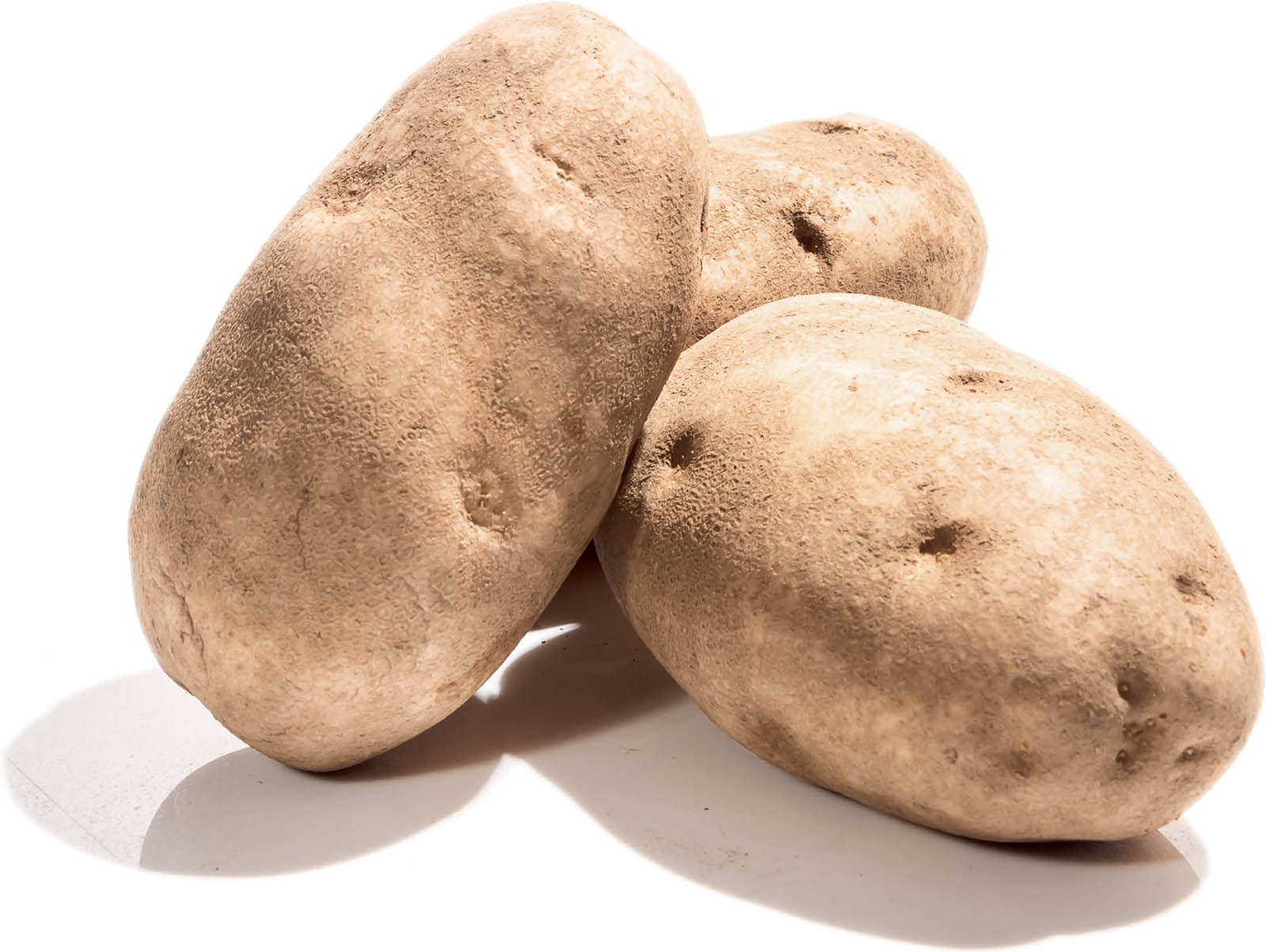
If there’s a case to be made for a single ingredient as one of the greatest Jewish foods of all time, allow me to make it for the potato. Adaptable, humble, and comforting, it’s an essential ingredient in many classic Jewish dishes: Sabbath stews, latkes, kugel, burekas, even fish and chips.
The potato transcends geography, class, and language. Ask a Jew about potatoes (really, it’s a great icebreaker) and they will tell you a story—about the scraps that sustained their ancestors through a war or a perilous journey, about the creamy chunks in their savta’s hamin, about the pleasure of a perfectly boiled Yukon Gold dipped in salt water at the beginning of the Seder meal. Someone will sing “Bulbes,” the classic Yiddish folk song about the quotidian tediousness of a potato-based diet. The potato is the Jewish ingredient ne plus ultra—it evokes notions of family, ritual, suffering, and history. Case closed.
by Alison Cayne
Makes sixteen to twenty 4-inch (10-centimeter) pancakes
3 Idaho russet potatoes, peeled
1 large egg, whisked
Fine sea salt
Extra-virgin olive oil, for frying
Flaky sea salt, such as Maldon, to finish
Optional Bonuses
¼ cup (32 grams) sliced or diced onion
¼ cup (14 grams) chopped fresh chives
Set up a landing station next to your frying area: Place a wire rack on a baking sheet and have a spatula handy.
Using the large holes of a box grater, grate the potatoes into a large bowl. (Alternatively, grate the potatoes using a food processor fitted with the shredding blade.) You should have about 4 cups shredded potatoes. Wrap the potatoes in a kitchen towel and squeeze out the excess moisture; squeezing should generate about ½ cup (120 milliliters) of liquid. The potatoes may turn a bit reddish-brown.
Put the potatoes back in the bowl. Add the egg and a large pinch of salt (the optional onion or chives can be added at this point) and mix the ingredients to combine.
Heat ¼ to ½ inch (6 millimeters to 1.5 centimeters) of oil in a large sauté pan over medium-high heat. When the oil begins to shimmer, start forming the patties. (You can test the temperature by putting the handle of a wooden spoon or a wooden chopstick into the oil; if the oil is hot, bubbles will form around it.)
Using your nondominant hand, scoop up about ⅓ cup (75 grams) of the potato mixture. Use the side of the bowl to help form the mixture into a patty. Drain any excess liquid into the bowl and gently lay the patty in the hot oil. Keep your other hand clean and dry so you can use your spatula and grab a towel if needed. Gently press the latke with the spatula until evenly flat. Repeat to make a few more patties, taking care not to crowd the pan. Fry until the edges brown and get lacy, 2 to 3 minutes. Flip and cook for 2 to 3 minutes more, until browned on the second side. Continually monitor and adjust the temperature of the oil while frying; too-hot oil will result in burnt edges and raw middles. Use the spatula to transfer the latkes to the wire rack, sprinkle with flaky sea salt, and serve hot.
Before frying the next batch, check your oil: If it is dark brown, smells, or is filled with burnt bits, ditch it and start with fresh oil. Wipe down the pan with paper towels, taking care not to burn yourself, then add more oil to coat the bottom again, heat the oil, and fry the remaining patties.
By Michael Twitty
As an African American Jewish culinary historian, I would like to think I know something about soul food. Just as gribenes are analogous to cracklings, the Jewish soul food equivalent of chitlins—the small intestine of the pig consumed during slaughtering time by enslaved people on Southern plantations—is a little gem known as ptcha. Never heard of it? Well, your family’s relationship with Jell-O, jelly rings, and the like started with this Eastern European Jewish delicacy, the jellied feet of calves. Despite the fact that most commercial gelatin isn’t kosher, Jews had their own jelly fascinations.
Ptcha, a word derived from Turkish, is just one of several regional terms, including fisnoga, sulz, and holodets, for this formerly popular Sabbath delicacy. The feet were boiled and served in their own aspic and flavored with as much garlic and onion as possible. Ptcha can in fact be seen as a means to ingest an enormous amount of garlic without being viewed as ostensibly meshuga, just as gefilte fish is just a vehicle for shoveling in as much horseradish as humanly possible.
Ptcha was popular because the feet symbolized, for peasants, the truth of Torah and Yiddishkeit, especially during the rise of Hasidism. Sheker, or “a lie” in Hebrew, teeters on one leg, while emes, or “truth,” solidly stands on four feet . . . kind of like a cow.
One can imagine how popular ptcha would have been. It used up a part of the animal perhaps considered inedible. The natural gelatin and fat kept it safe overnight in the days before refrigeration. The onion and garlic not only added antiseptic powers, unbeknownst to the shtetl, but also provided essential nutrients that staved off deficiencies like scurvy. Ptcha was what much soul food is about: rescued odds and ends turned into a delicacy with symbolic meanings that turn out to have real benefits. If, that is, you can eat past the no-thank-you bite.
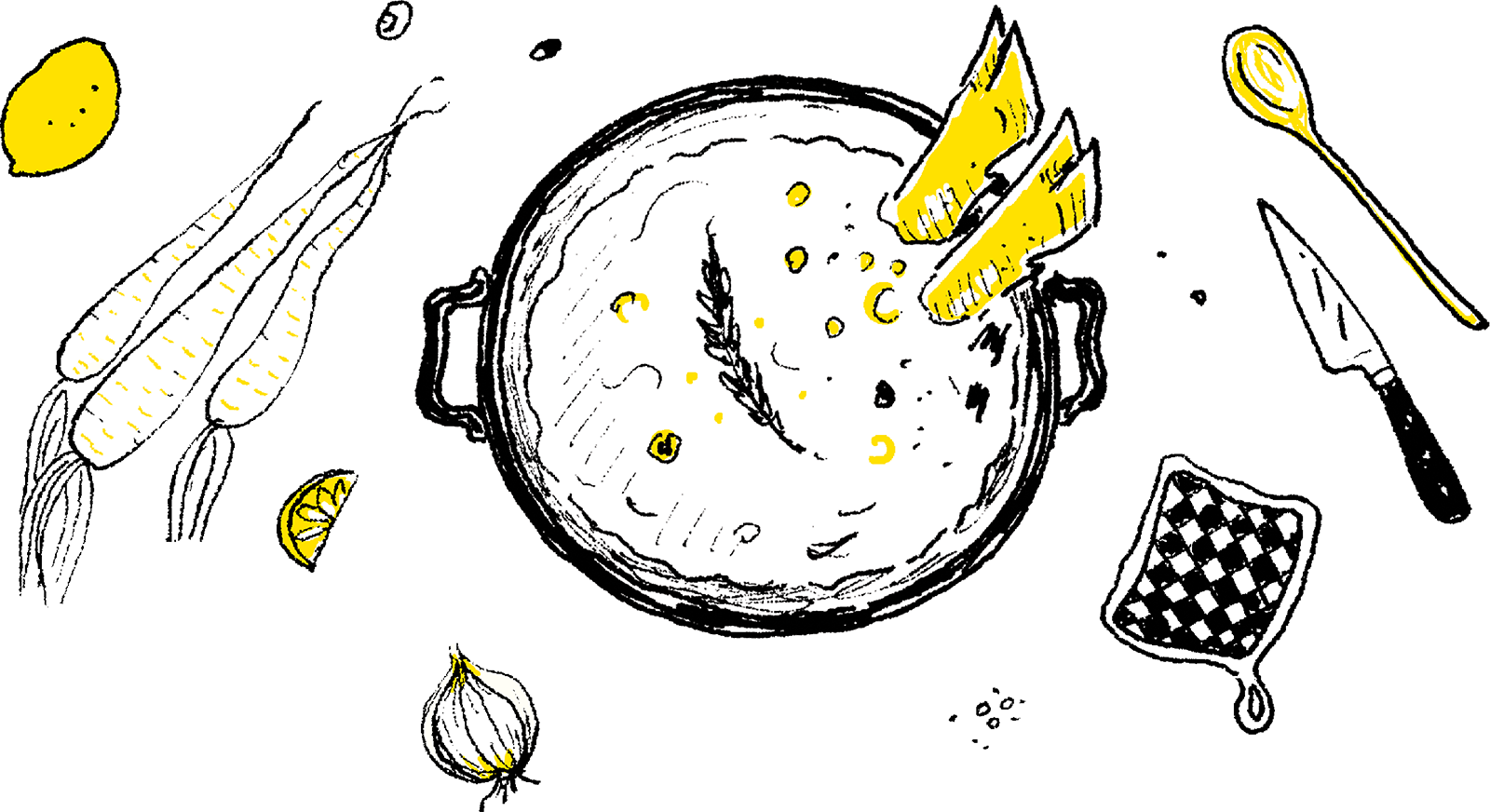
By Ruth Reichl
My father arrived in America in 1926. He was twenty-six years old, and he carried three things with him: a doctorate in German literature, a burning desire to work in publishing, and an utter contempt for American food.
He never changed. Dad looked at the cereal Mom and I occasionally breakfasted upon with loathing. He considered salad strange. The only vegetable that ever crossed his plate was red cabbage (preferably with sauerbraten). And although he was a gentle man, he refused to partake of any meal that lacked a basket of bread.
“Not those fluffy white slices that evaporate in your mouth,” Dad said contemptuously. He wanted sturdy stuff you could sink your teeth into, a loaf with heft, color, and character. To please him, Mom went to the bakery every morning for a fresh loaf of seeded corn rye. There is no corn in corn rye; Korn is the medieval German term for “grain,” but in bread it almost always refers to rye. The seeded corn ryes of my childhood were sourdough loaves, yeasty, light, and so rich with caraway seeds that their fragrance perfumed the entire table.
I hated that bread. It was embarrassing to show up at school with a lunchbox filled with thick sandwiches on mismatched slices that permeated the lunchroom with their telltale scent. I longed for the pristine square sandwiches other moms made, those clean, white envelopes with their innocent airs. I swore that when I grew up, I would never eat another slice of rye. But as New York’s German population faded away and its Jews assimilated, their breads began to vanish. Corn rye became a thing of the past, and to my surprise, I missed it.
Happily, the artisan-bread movement has started bringing the old loaves back, and I find myself buying corn rye with increasing frequency, so eager for that familiar flavor that the loaf’s half gone before I reach home. It is, I realize, the taste of my childhood. And it occurs to me that, in this case, Father really did know best.